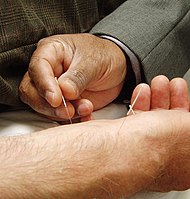
Photo from wikipedia
Background: Migraine is a chronic neurological disorder characterized by attacks of moderate or severe headache and various neurological symptoms. Migraine is typically treated by pharmacological or non-pharmacological therapies to relieve… Click to show full abstract
Background: Migraine is a chronic neurological disorder characterized by attacks of moderate or severe headache and various neurological symptoms. Migraine is typically treated by pharmacological or non-pharmacological therapies to relieve pain or prevent migraine attacks. Pharmacological therapies show limited efficacy in relieving headache and are often accompanied by adverse effects, while the benefits of acupuncture, a non-pharmacological therapy, have been well-documented in both the treatment and prevention of acute migraine attacks. However, the underlying mechanism of the effect of acupuncture on relieving migraine remains unclear. Recent advances in neuroimaging technology have offered new opportunities to explore the underlying neural mechanism of acupuncture in treating migraine. To pave the way for future research, this review provides an overview neuroimaging studies on the use of acupuncture for migraine in the last 10 years. Methods: Using search terms about acupuncture, neuroimaging and migraine, we searched PubMed, Embase, Cochrane Central Register of Controlled Trials, and China National Knowledge Infrastructure from January 2009 to June 2020 for neuroimaging studies that examined the effect of acupuncture in migraine. All published randomized and non-randomized controlled neuroimaging studies were included. We summarized the proposed neural mechanism underlying acupuncture analgesia in acute migraine, and the proposed neural mechanism underlying the sustained effect of acupuncture in migraine prophylaxis. Results: A total of 619 articles were retrieved. After removing reviews, meta-analyses, animal studies and etc., 15 articles were eligible and included in this review. The methods used were positron emission computed tomography (PET-CT; n = 2 studies), magnetic resonance spectroscopy (n = 1), and functional magnetic resonance imaging (fMRI; n = 12). The analyses used included the regional homogeneity (ReHo) method (n = 3), amplitude of low frequency (ALFF) method (n = 2), independent component analysis (ICA; n = 3), seed-based analysis (SBA; n = 1), both ICA and SBA (n = 1), Pearson's correlation to calculate functional connectivity (FC) between brain regions (n = 1), and a machine learning method (n = 1). Five studies focused on the instant effect of acupuncture, and the research objects were those with acute migraine (n = 2) and migraine in the interictal phase (n = 3). Ten studies focused on the lasting effect of acupuncture, and all the studies selected migraine patients in the interictal phase. This review included five task-based studies and 10 resting-state studies. None of the studies conducted a correlation analysis between functional brain changes and instant clinical efficacy. For studies that performed a correlation analysis between functional brain changes and sustained clinical efficacy, the prophylactic effect of acupuncture on migraine might be through regulation of the visual network, default mode network (DMN), sensory motor network, frontoparietal network (FPN), limbic system, and/or descending pain modulatory system (DPMS). Conclusion: The neural mechanism underlying the immediate effect of acupuncture analgesia remains unclear, and the neural mechanism of sustained acupuncture treatment for migraine might be related to the regulation of pain-related brain networks. The experimental design of neuroimaging studies that examined the effect of acupuncture in migraine also have some shortcomings, and it is necessary to standardize and optimize the experimental design. Multi-center neuroimaging studies are needed to provide a better insight into the neural mechanism underlying the effect of acupuncture on migraine. Multi-modality neuroimaging studies that integrate multiple data analysis methods are required for cross-validation of the neuroimaging results. In addition, applying machine learning methods in neuroimaging studies can help to predict acupuncture efficacy and screen for migraineurs for whom acupuncture treatment would be suitable.
Journal Title: Frontiers in Neuroscience
Year Published: 2021
Link to full text (if available)
Share on Social Media: Sign Up to like & get
recommendations!